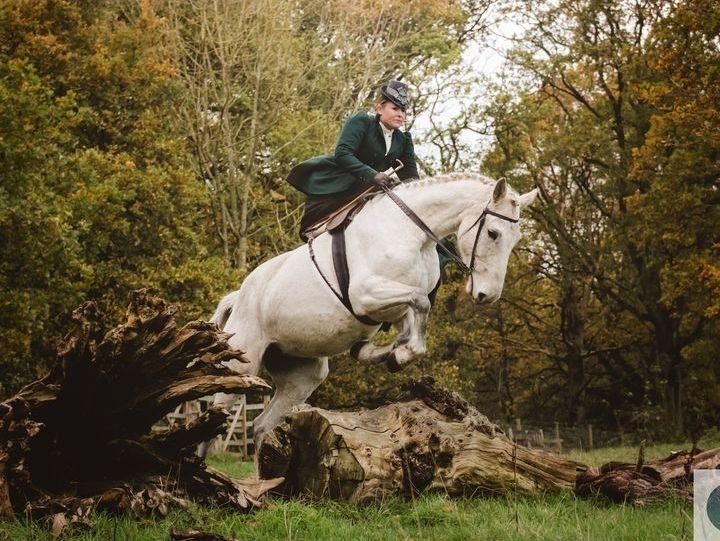Ride like a Girl

In 2009, surrounded by the Norman ruins of Richmond Castle, North Yorkshire, I fell in love.
The summer grass made the perfect arena for the four horses performing. Troopers in full uniform and stunning ladies riding side saddle took me back to Victorian England, and from that moment, I knew I wanted to ride sideways. I imagine that many people come to side saddle that way.
The romantic elegance is alluring to most.
Now, I love putting on a long wool habit, gorgeous hat and facing my big mare at the nearest solid fence. But that’s not all we do...
I’ll start at the beginning, but it’s hard to be sure where the beginning of side saddle is. From the 14th century, fine ladies rode completely sideways on a padded seat with a ‘planchette,’ or plank, for her feet to rest . As these women were usually led, it didn’t matter that they didn’t face forwards. With the rise in popularity of hunting, women needed to steer their own horses and move faster to keep up. Two hundred years later, hooking a knee over the pommel enabled the rider to face forward but still be considered sideways. It is important to note that women also rode astride throughout history.
I had the opportunity to try an Elizabethan side saddle a few years ago, owned by English Heritage. My very obliging mount did trot, but it was a very different experience than the ‘modern’ side saddle I ride in regularly.
By the 1800s, the ‘fixed head,’ or top pommel, and offside pommel cupped the right thigh and provided stability. This saddle seems straight out of a Jane Austen novel. Women could happily canter in the park - skirts, but not the rider, secured down for modesty.
Now we’re nearing the really exciting part. During the Victorian era, the aptly called ‘leaping head’ was developed to give women their best chance at keeping up with the men on the hunting field, allowing female riders to deftly balance over any hedge or obstacle.
This pommel gave extra purchase and grip when the left knee was raised into it. Between the right leg squeezing down and the left leg squeezing up, a rider was firmly attached to the saddle and therefore the horse. Over time the offside pommel shrank and disappeared, no longer needed, and we get to the side saddle we recognise today. You can spot the Victorian side saddle on all the period dramas from Poldark to Downton Abbey to Bridgerton.
So here we are...
Were women forced to ride side saddle as a way of preserving their virtue, and, if so, why do we still even ride aside?
Surely it’s irrelevant and should be kept for historic displays and oil paintings?
Well, I think it is relevant. It is part of women’s history and, perhaps initially it was merely a form of transportation, yet it quickly became a way for women to keep up with men on their own saddle, in complete control of their own horse.
But it’s also a part of men’s history. Male grooms would have always ridden sideways to train the ladies’ horses, to bring them fresh horses when hunting, or riding them home when the woman was tired and wanted to ride in her carriage. Soldiers injured in the Great War could use side saddle as a way to keep them riding. Men still ride sideways, when hunting and competing. It is a way that Paralympians can perform at the highest level, working with their four-legged partner in the kind of synergy we all aspire to, astride or aside.
"But it’s so dangerous; it must be, with your legs on one side, you aren’t balanced." "It hurts the horse to ride like that."
Yes, riding side saddle is dangerous. Riding is dangerous. You’re willingly getting on a creature that has its own opinions, behaviours and instincts. But better horsewomen than me have said they preferred to get on a difficult mount sideways because they felt more secure.
I was out once on a ride and a child on lead-rein told me that she preferred to ride her pony side saddle because it was harder for the pony to get her off. Those are the kind of stories I love to hear...
Real-world applications of an ancient discipline. If it was designed to subjugate women, it certainly didn’t work.
When I started learning side saddle in late 2018, I took lessons from anyone who had a side saddle and would teach me. I walk-trot-cantered my first time and was so giddy. It can be like Marmite; you either love it or you hate it. And I was relieved that I loved it, because I knew it was only the start of the journey.
My ‘everyday’ side saddle is from the 1930s, which makes it a very old lady indeed. It’s remarkable that I’m able to use her as frequently as I do and for what I do – dressage, show jumping, cross country, barrel racing, point-to-point racing, gymkhanas, tent pegging, skills at arms, the list goes on. It is not only a credit to the original maker but, also to the love of all the women who have owned her before me. This saddle is currently getting a much-needed spa break with a master side saddler.
I am often the only competitor riding side saddle in a field of very capable astride riders. I prefer to take the challenge of unadapted courses, pitting their skill equally against mine, (side saddle riders find right rein easier, so many courses designed for aside riders will be around the right rein with no doubles).
One of my proudest moments came when I competed in a one-day event sideways against two astride riders. We were on the same score after the dressage. A bit of trash talk in the warm-up, which usually sounds like ‘I would never ride like that’ or ‘You must be really brave to jump side saddle!’, I went out to the showcross phase and completed the round with four faults. I was also the only competitor to have finished the course, as the other two riders were unhorsed at the final fence.
I still feel smug about winning because I had prepared my horse and myself for this exact moment.
You see, without a leg on the offside, squeezing is impossible. You have a stick to use as a leg aide, but it’s more of a reminder to a well-schooled horse that they are meant to take off now. My 16.3 Irish Sports Horse, Memphis Belle (Bella), was purchased as a low-mileage nine-year-old specifically to do side saddle with me. She was the right size and temperament to do it, the only requirement when I bought her. But most horses take to side saddle. There is no certain breed or type, just a well-mannered horse, that you can get a side saddle to fit. The shape of modern horses does make it difficult to find extra-wide side saddles, but luckily there are ways and means.
We’ve had our moments. I remember a particularly humiliating experience at a re-enactment training session when Bella lost her mind and it was the first and only time that I thought she would get me off. I was scared and cried in front of everyone. It was my ‘come to Jesus’ moment.
I had to finish the training but afterwards I had to decide not only what I wanted from her but from side saddle and myself.
I had the choice to double-down and work on building her confidence and our partnership or give up.
I don’t like feeling scared or over-horsed. And, as Bella was getting more powerful and head strong, I doubted my ability to deal with it. Could I be the horsewoman she needed me to be?
I dug in. I couldn’t give up on this amazing mare, my heart horse, the equal of me in every way!
I found a coach who understood my fears and ignored them. We took a little break from side saddle to get a better foundation jumping (as we were both novices). I want to do everything I can sideways. You often hear this statement, that side saddle riders are the Ginger Rogers of the equestrian world: that they do everything an astride rider can do, but backwards and in heels. I am the current Side Saddle Association National Arena Eventing Champion. I have competed all over Yorkshire on equal footing with astride riders, who have better horses, better training facilities, better opportunities.
Why am I so passionate about showing the world side saddle?
Because I feel that side saddle is relevant, current and important. Yes, it’s sometimes about corsets and fancy habits, but it’s also about working with your horse to develop a trust and togetherness that can’t be matched by any other discipline.
I’m worried about it, too. Although I safely gallop and jump sideways, many places are closing their doors to us. British Riding Clubs (BRC) have said that side saddle is not allowed for jumping or hunter trials, so any events that run under BRC insurance/rules disallow me from competing in my preferred way. When you enter a competition, you are expected to be capable of riding to that level. You are still riding at your own risk. Therefore, I and other side saddle riders shouldn’t be excluded.
This is a global concern, as the side saddle opportunities are shrinking in Australia, too, for the same reasons. I would love for this ancient skill to be championed and welcomed in every discipline. It’s not just for show and tell. It is a way of life.


